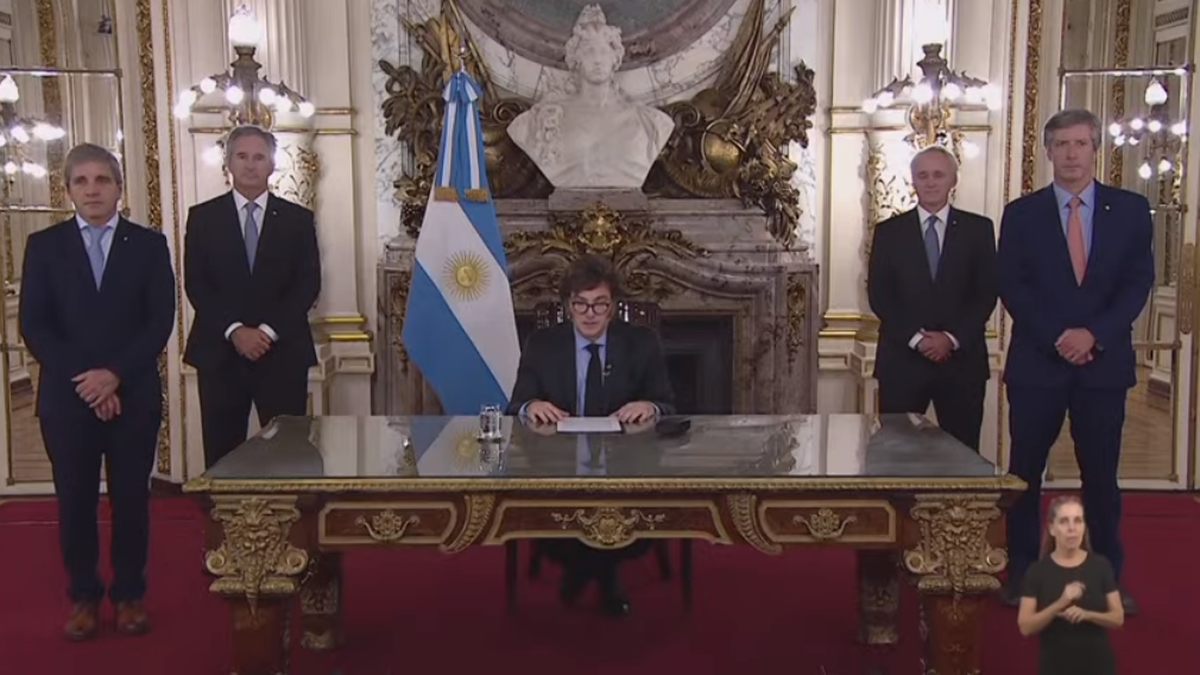For President Javier Milei, the fiscal surplus is not only a tool of economic policy. It is the “only starting point to end inflationary hell forever.” The opposite of it, the deficit, was recorded “in 113 of the last 123 years”. In his speech, he assured that during the previous administration he achieved “five points of GDP in the Treasury and another 10 points in the BCRA”. The focus on the inheritance received.
Finally, the president made the national broadcast to celebrate a financial surplus of 0.2% of GDP during the first quarter of the year. In March, the accumulation was $276,638 million. For Milei, it is a “milestone that should make us all proud” because something like that was not recorded since 2008 and given the “loud” inheritance that he had to take care of.
In that sense, he highlighted what he has mentioned since his first official speech: the inheritance of a “consolidated deficit” of over 15 product points “between Treasury deficit and Central Bank deficit.” “Having adjusted 13 points of those 15 in just three months of Government is simply a feat of historic proportions worldwide.”, highlighted Milei, in the company of his economic team.
Due to that same deficit, which he claims to be correcting in an “economically sustainable and morally desirable” way, he generated during the administration of Alberto Fernández “a bankrupt country on the verge of hyperinflation” with an “exchange gap” that ranged 200% between the official dollar and the free dollar and a monetary surplus that emulated the previous one of the Rodrigazo“one of the worst crises in our history,” for the President.
At the same time, he counted a debt “not recognized” with importers for more than US$50 billion and other passive in pesos by the equivalent of US$90 billion. In this context, he also warned that the agreement with the International Monetary Fund (IMF), “was already down”. The last disbursement delivered by the organization was for US$4.7 billion with a deadline of April 30.
Regarding inflation, which from December to March slowed from 25% to 11%, which is why Luis Caputo, Minister of Economy, considered days ago that it is “collapsing”, was running during the first week of Government to the “1.2% daily”.
The daily velocity of prices, measured by the President, reveals “an inflation running at 7,600% annually, with a monetary surplus and a bankrupt Central Bank, which would have led to inflation at 15,000%”.
For this reason, the president goes back to the time of the Rodrigazo and adds that he received “a destruction of the BCRA balance worse than the inflation of the 89 and social indicators worse than those of the crisis of the year 2001”. In conclusion, Milei concluded that “we were facing the worst crisis in the history of our country”.
In this way, the need for a fiscal surplus has to do with “end once and for all the inflationary hell that was Argentina since the fall of convertibility”, but also with “having become the largest serial defaulter in the world” and having the “highest tax pressure in the world.”
For Kevin Castillo, economist and Member of the Policy Observatory for the National Economy (OPEN), “urgent decisions had to be made regarding the fiscal and quasi-fiscal deficit“, although “the way in which this Government implements the measures to achieve the surplus can be discussed.”
However, he agrees “with many colleagues” that the inflation projection is “extremely exaggerated“, rather responds to a way of “discursively weather these months of very high inflation”. Generally speaking, he understands that “it is not so much the diagnosis” but the “subsequent actions” that he disagrees with.
Guido Zack, director of Economics at the Fundar organization, agrees with the initial view: “without a doubt the economy that Milei receivedwith prices and exchange rates lagging, the economy without growing and the BCRA with net reserves, It was very difficult”.
Even so, he highlights that “In economics there is never a single alternative” and the President “decided to overreact by devaluing more than the IMF and the market expected and generate a fiscal consolidation that achieves a financial surplus, and not a primary balance.”
Therefore, he points out that the other side of that coin is “more recession and impact on income”. Regarding the methodology to measure inflation in 2023, Zack agrees with Castillo, ensuring that “It is totally imprecise”. But he also noted that “Talking about a consolidated deficit of 15% of GDP is clearly a mistake”.
As the economist explains, Milei includes in the 2023 deficit the interest on remunerated liabilities of the BCRA and in the measurement of the accumulated surplus during the first tranche of its management, it does not. “If we included the interest on repos in the quarter, which amounts to $10 billion, we would have a deficit”says Zack.
Nor does he believe that the surplus achieved can be sustainable over time if the recession deepens and the postponement of payments to the energy sector or the accumulation of floating debt continues. “Neither financial stability, fiscal balance, accumulation of reserves and sustainability of the exchange rate are at all assured. Not even the downward path of inflation is stable under these conditions“, stated the specialist.
Source: Ambito




